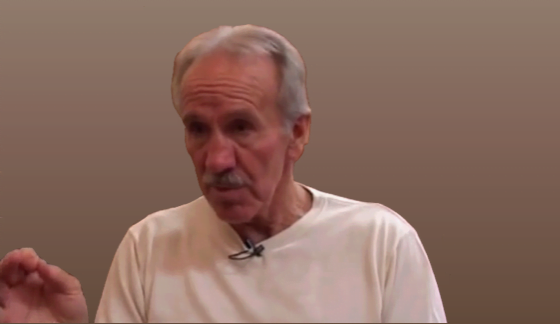John Grinder is acknowledged as one of the three co-creators of NLP, alongside Richard Bandler and less famously, Frank Pucelik.
John was born in 1940. John’s undergraduate degree was in psychology; immediately after graduating, in 1962, he entered the US Army as an officer. Subsequently he became a member of the Special Forces. After five years in the forces and now speaking German and Italian, he returned the US to begin his postgraduate degree at UC-San Diego – in the field of linguistics. This became his speciality. He went on to work as a linguistics professor at the University of California, Santa Cruz, which is where he met Richard Bandler.
Robert Dilts worked with John Grinder in the 1970s in the early days of NLP. Dilts describes Grinder from his memories of that time: “Grinder was unlike any other other college professor I had ever met. In his mid-thirties at the time, John was dynamic, charismatic, physically vital and powerful, confident, curious, and indisputably intelligent and talented.”
Dilts also said – “His commitment to congruence and his willingness to bypass bureaucratic rigidity” characterised Grinder.
Grinder describes himself as a “committed revolutionary.” In the 1970s he could often be found working with one anti-bureaucratic movement or another.
Linguistics and meeting with Richard Bandler
As he was beginning his work as a linguistics professor in 1971, Grinder was approached by Richard Bandler to assist in working with a group of Gestalt therapy students that Bandler and friend Frank Pucelik had gathered together. Bandler told Grinder that he was getting some amazing change results with his students but one part of the jigsaw was missing, he couldn’t find a way of helping the students to gain the same results with their patients. He needed someone to find a way to communicate the processes that they were using in a way that would form a transfer of skills. Essentially they were finding it difficult to put their skills into words, a speciality of linguistic expert Grinder.
Grinder was fascinated by the what he saw in attending the first few seminars with Bandler and saw an opportunity to use his skills in providing the missing piece of the jigsaw.
Grinder assisted Bandler with his continuing study of Fritz Perls, the Gestalt Therapist and Virginia Satir, the family therapist. Grinder began noticing patterns in the language that the therapists used to get the results with their patients, out of this eventually came the NLP Meta Model. The pair went on to model (a process of studying, copying and replicating) Milton Erickson, a psychiatrist and medical hypnotist, out of this project came the Milton Model language patterns of NLP.
Books
As their working partnership progressed Grinder and Bandler wrote several books together, The Structure of Magic I: A Book About Language and Therapy, and The Structure of Magic II: A Book About Communication and Change (1975) and Patterns of the Hypnotic Techniques of Milton H. Erickson, M.D. Volume I (1976) and Frogs into Princes: Neuro Linguistic Programming (1979).
Grinder had become a prolific author and amongst other books his most notable work concerning NLP was the book that he wrote with Judith Delozier, Turtles All the Way Down: Prerequisites to Personal Genius (1987).
Grinder and Bandler hosted therapy practice groups where they experimented with their students using their new skills and then taught the students how to do it themselves. This became the methodology for teaching NLP.
NLP
The body of knowledge that we now know of as NLP was given the title in the late 1970s by Grinder and Bandler as Bandler was keen to brand and monetise the set of skills that they had developed.
The Grinder/Bandler Split and a New Code of NLP
Around the end of the 1970s it became obvious to Grinder that he and Bandler were operating with slightly different agendas. Their relationship was starting to fracture. Grinder was keen to keep his work “clean”. He has always promoted ecology in change work, that is studying the consequences, making sure that it is a good idea for all involved. When he and Bandler split he started promoting New Code NLP with this slightly more obviously ethical approach. This is the approach favoured now by most NLP trainers including ourselves.
Gregory Bateson, the anthropologist had a big influence on Grinder (and Bandler) in the early 1970s and possibly Grinder was recognising Bateson’s intent with his ethical stance towards NLP.
Grinder and Bandler’s relationship eventually descended into mutual lawsuits. Grinder responded to an initial lawsuit from Bandler with one of his own. They contested the intellectual property rights of NLP in court. The pair eventually settled their differences and agreed that they were co-creators of NLP. The courts ruled that NLP as a body of knowledge was in the public domain and therefore was under general public ownership rather than being the property of one or a group of individuals.
Now well into his 70s, Grinder continues to influence the NLP community and promote his New Code of NLP.

